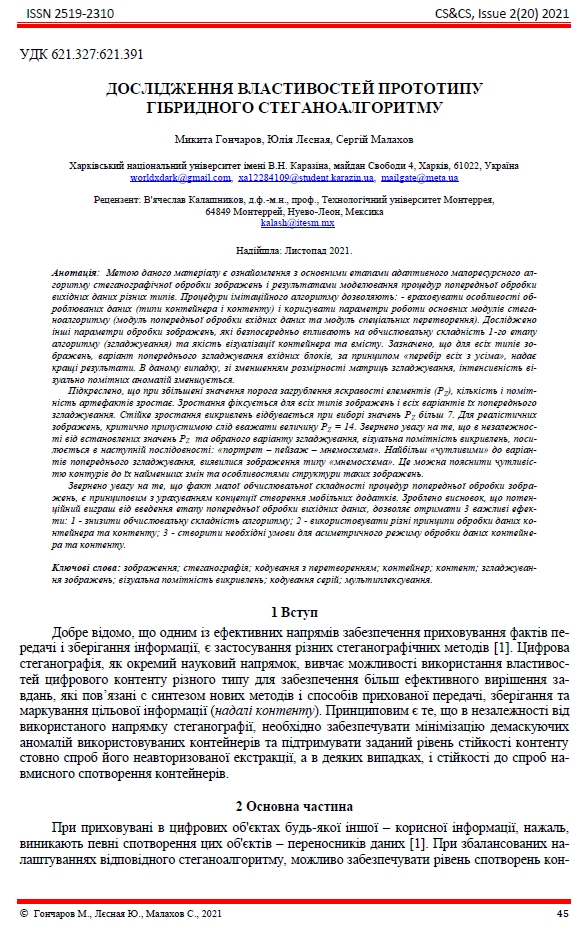Investigation of the properties of the prototype of a hybrid steganographic algorithm
Abstract
The purpose of this material is to get acquainted with the main stages of the adaptive low-resource algorithm of steganographic image processing and the results of modeling the procedures of pre-processing of source data of different types. The simulative algorithm procedures allow: - take into account the features of processed data (types of container and content) and to adjust parameters of operation of main modules of a steganoalgorithm (the module of preprocessing of input data, and the module of specia conversions). Other image processing parameters that are directly investigated affect the computational complexity of the 1st stage of the algorithm (smoothing) and the quality container and content visualization. It is noted that for all types of images, the option of pre-smoothing the input blocks, on the principle of "busting everyone with everyone", provides better results. In this case, with reducing the dimensionality of anti-aliasing matrices, the intensity of visually noticeable anomalies decreases. Underlined that when the threshold for adjusting the brightness of elements (PZ) increases, the number and visibility of artifacts is increasing. Growth is fixed for all types images and all options for their pre-smoothing. Steady growth of distortions occurs when choosing values of PZ, more than 7. For realistic images, the value PZ = 14 should be considered critically valid. Attention is drawn to the fact that regardless of the established values of PZ and the selected smoothing option, visual visibility of distortions, intensifies in the following sequence: «portrait – landscape – mnemonic». The most "sensitive" to the options for pre-smoothing, were mnemonic chart image. This can be explained by the sensitivity of the contours to their changes and structure of such images. Attention is drawn to the fact that the low computational complexity of the previous procedures image processing is fundamental given the concept of creating mobile applications. It is concluded that the potential winnings from the introduction of the preprocessing stage output data allows you to get 3 important effects: 1 - reduce computational complexity algorithm; 2 - use different principles of container and content data processing; 3 - create the necessary conditions for the asymmetric mode of data processing of the container and content.
Downloads
References
Грибунин В.Г. Цифровая стеганография / Грибунин В. Г., Оков И. Н., Туринцев И. В. – М.: Солон-Пресс, 2002. – 272 с.
Зубарев Ю.Б., Дворкович В.П. Цифровая обработка телевизионных и компьютерных изображений. – М.: МЦНТИ, 1997. – 212 с.
Ярославский Л.П. Введение в цифровую обработку изображений. – М.: Сов.Радио, 1979. – 312 с.
Гончаров М. О., Малахов С. В. Моделювання процедур підготовки даних стеганоалгорітма з багаторівневим мультиплексуванням контенту. Комп’ютерне моделювання в наукоємних технологіях (КНМТ-2021): матеріали 7-ї міжнар. наук.-техн. конф., 21-23 квіт. 2021 р. Харків: ХНУ ім. В.Н. Каразіна. http://www-csd.univer.kharkov.ua/wp-content/uploads/2018/02/www-csd.univer.kharkov.ua-maket-pdf-konf.pdf
Обработка изображений на ЭВМ / Е.А Бутаков, В.И. Островский, И.Л. Фадеев. – М.: Радио и связь, 1987. – 240 с.
Прэтт У. Цифровая обработка изображений. т. 1,2. - М.: Мир, 1985. - 736 с.
Быков С.Ф. Алгоритм сжатия JPEG с позиции компьютерной стеганографии / Защита информации. Конфидент. – СПб.: 2000, № 3. – С. 26.
Morozov, D., Shaforostov, M., Malakhov, S., & Serbin, V. (2018). Подвійна обфускація трансформант малоресурсного стеганоалгоритма. Комп’ютерні науки та кібербезпека, 9(1), 22-34. Вилучено із https://periodicals.karazin.ua/cscs/article/view/12015
Гончаров М. О. Дослідження процедур попередньої підготовки вихідних даних для стеганоалгоритма. Сучасні напрями розвитку інформаційно-комунікаційних технологій та засобів управління: матеріали 11-ї міжнар. наук.-техн. конф., 8–9 квіт. 2021 р. м. Баку–Харків–Київ–Жиліна. т. 2. с. 63. URL: http://repository.kpi. kharkov.ua/handle/KhPI-Press/52020 (дата звернення 01.11.2021).
Гончаров М.О. Моделювання та дослідження властивостей гібридного внутрікадрового стеганоалгоритму: Пояснювальна записка до дипломної роботи бакалавра: напрям підготовки 125 – Кібербезпека / М. О. Гончаров; Харківський національний університет імені В. Н. Каразіна. – Харків: [Б. В.], 2021. – 75 с.


